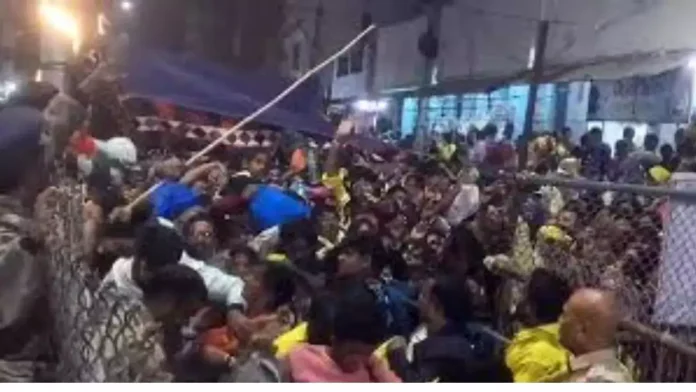Tirupati Stampede has left a devastating impact, claiming at least six lives and injuring several others during a chaotic event at Vishnu Nivasam in Tirupati. Among the victims was a woman whose grieving husband discovered her tragic fate only through a viral video of the incident, raising serious concerns about crowd management and public safety at large gatherings.
The Tragedy Unfolds in Tirupati
The stampede occurred during a high-profile event at the Vishnu Nivasam pilgrimage complex in Tirupati. Overwhelmed by a massive influx of devotees, the crowd quickly spiraled into chaos, with people trampling over one another in the rush.
One of the victims was a woman whose husband desperately searched for her in nearby hospitals after the stampede. Despite his efforts, he was unable to find her or receive any official communication about her status. Heartbreakingly, he only confirmed her death after recognizing her in a viral video of the tragedy.
Crowd Management Failures
The Tirupati incident has reignited debates over poor crowd management at religious and public events in India. Large gatherings are common at pilgrimage sites, but inadequate planning and insufficient safety measures often lead to devastating consequences.
Experts have identified key failures in this incident:
- Lack of Proper Entry and Exit Points: Poorly organized access areas contributed to the stampede as people surged into confined spaces.
- Inadequate Security Measures: Insufficient deployment of security personnel made it challenging to manage the swelling crowd.
- Absence of Emergency Protocols: A lack of clear evacuation routes and medical aid facilities exacerbated the situation.
A Familiar Pattern of Neglect
Unfortunately, the Tirupati stampede is not an isolated event. India has witnessed numerous stampedes at religious sites and public gatherings over the years. Some notable examples include:
- The 2008 Naina Devi Temple Stampede, which claimed 145 lives due to rumors of a landslide.
- The 2013 Ratangarh Temple Stampede, where over 115 people died after a bridge collapsed under the pressure of a crowd.
- The 2022 Vaishno Devi Stampede, which occurred due to overcrowding during New Year celebrations.
Why do such tragedies continue to occur? Experts point to systemic neglect of crowd management protocols, an underestimation of turnout, and a lack of technological tools to monitor and regulate crowd density.
The Role of Technology in Crowd Safety
Modern technology can play a critical role in preventing stampedes and ensuring public safety. Tools like AI-based crowd density monitoring systems and real-time surveillance cameras can help authorities identify potential risks and act swiftly.
Potential Solutions Include:
- Drones for Crowd Monitoring: Real-time aerial views can provide better visibility and help spot bottlenecks or overcrowded zones.
- Digital Ticketing Systems: Limiting attendance through pre-registered tickets can prevent overcrowding.
- Automated Alerts: Sensors that detect crowd pressure can trigger automated alerts, allowing authorities to disperse crowds before they become unmanageable.
The Human Toll of Negligence
Beyond the statistics and systemic failures, incidents like the Tirupati stampede leave behind grieving families whose lives are forever changed. For the husband who found out about his wife’s death through a viral video, the lack of official communication adds to the trauma.
Questions that remain unanswered include:
- Why was there no proper system to identify and communicate with the families of victims?
- Why weren’t hospitals and authorities equipped to handle the aftermath efficiently?
Such lapses highlight the need for better disaster response systems, including designated help desks and communication channels for families during emergencies.
Public Safety vs. Religious Sentiments
Managing large crowds at religious sites often involves balancing public safety with the sentiments of devotees. Pilgrimage sites hold deep spiritual significance, and restricting access or implementing strict protocols is often met with resistance.
However, experts argue that safety must take precedence over convenience. Proper planning, transparent communication, and collaboration between authorities and religious organizations are essential to preventing future tragedies.
Voices for Change
Following the Tirupati incident, there has been a growing demand for stricter safety regulations at public events. Social media platforms have amplified voices calling for accountability and change.
- Activists have urged the government to conduct a thorough investigation into the incident and take punitive action against those responsible for the lapses.
- Families of Victims have called for better crowd management policies to ensure no one else suffers a similar fate.
Learning from Global Best Practices
Countries like Japan have set examples in crowd management, particularly during high-density events like festivals and sporting events. Some practices include:
- Designated Crowd Marshals: Trained personnel who guide and control the flow of people.
- Pre-Event Risk Assessments: Comprehensive evaluations of potential hazards and preparation of contingency plans.
- Public Awareness Campaigns: Educating attendees on safety protocols and emergency procedures.
India can adopt similar practices to safeguard lives and maintain order during large gatherings.
A Call for Urgent Action
The Tirupati stampede is a wake-up call for authorities, religious organizations, and citizens. Preventing such tragedies requires proactive measures, from using technology to enforcing stricter regulations and improving on-ground coordination.
As the families of victims mourn their loss, the larger question remains: How many more lives need to be lost before meaningful changes are implemented?



